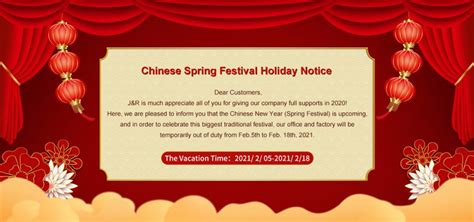Spring Festival Schedule Overview
The Spring Festival is a 15-day celebration that starts on the first day of the Lunar New Year and ends with the Lantern Festival on the 15th day. Here is an overview of the key dates and events during the 2019 Spring Festival:
| Date | Event |
|---|---|
| February 4th | New Year’s Eve |
| February 5th | Spring Festival (Lunar New Year’s Day) |
| February 6th – 10th | Spring Festival Golden Week |
| February 19th | Lantern Festival |
New Year’s Eve (February 4th)
New Year’s Eve, also known as Chuxi (除夕), is the day before the Lunar New Year. It is a time for families to gather, enjoy a reunion dinner, and prepare for the coming celebrations. Some common activities on New Year’s Eve include:
- Cleaning and decorating the house
- Preparing and eating the reunion dinner
- Watching the Spring Festival Gala on TV
- Setting off firecrackers and fireworks at midnight
Reunion Dinner
The reunion dinner is the most important meal during the Spring Festival. Family members from near and far come together to enjoy a feast that typically includes dishes such as:
- Jiaozi (dumplings)
- Nian gao (sticky rice cake)
- Yu (fish)
- Longevity noodles
- Tangyuan (sweet rice balls)
Each dish has a symbolic meaning, often related to prosperity, happiness, and longevity.
Spring Festival (Lunar New Year’s Day) (February 5th)
The first day of the Lunar New Year is the official start of the Spring Festival. It is a day for visiting family and friends, exchanging red envelopes (hongbao) containing money, and enjoying traditional activities. Some common customs on this day include:
- Wearing new clothes, often in red
- Giving and receiving red envelopes
- Offering sacrifices to ancestors
- Setting off firecrackers and fireworks
- Watching lion and dragon dances
Red Envelopes (Hongbao)
Red envelopes, or hongbao (红包), are small, red packets containing money that are given as gifts during the Spring Festival. They are typically given by married couples or elderly family members to children and unmarried adults. The amount of money in the red envelope can vary, but it is usually an even number as odd numbers are associated with funerals.
Spring Festival Golden Week (February 6th – 10th)
The first seven days of the Spring Festival are known as the Golden Week, a national holiday in China. During this time, many people travel to visit family and friends or go on vacation. Some popular activities during the Golden Week include:
- Temple fairs
- Scenic spot tours
- Shopping and dining out
- Enjoying cultural performances and events
Temple Fairs
Temple fairs are a traditional part of the Spring Festival celebrations. They are usually held in or near temples and feature a variety of activities, such as:
- Food and craft stalls
- Traditional performances (e.g., opera, acrobatics, folk music)
- Games and carnival rides
- Ritual prayers and offerings
Some famous temple fairs in Beijing include the Ditan Temple Fair, Dongyue Temple Fair, and Changdian Temple Fair.
Lantern Festival (February 19th)
The Lantern Festival, or Yuanxiao Jie (元宵节), marks the end of the Spring Festival celebrations. It falls on the 15th day of the first lunar month and is a time for enjoying lanterns, solving riddles, and eating tangyuan (sweet rice balls). Some popular Lantern Festival activities include:
- Enjoying lantern displays and light shows
- Guessing lantern riddles
- Eating tangyuan
- Watching folk performances, such as lion and dragon dances
Lantern Riddles
Lantern riddles are a traditional part of the Lantern Festival celebrations. Riddles are written on paper and attached to lanterns, and people try to solve them as they admire the lantern displays. Solving a riddle often earns a small prize, such as a bookmark or a candy.
FAQ
-
Q: What is the significance of the Spring Festival in Chinese culture?
A: The Spring Festival is the most important traditional holiday in China, marking the beginning of a new year according to the lunar calendar. It is a time for family reunions, celebrating the coming of spring, and engaging in various cultural activities and traditions. -
Q: How long does the Spring Festival last?
A: The Spring Festival lasts for 15 days, starting from the first day of the Lunar New Year and ending with the Lantern Festival on the 15th day. -
Q: What are some common activities during the Spring Festival?
A: Common activities during the Spring Festival include enjoying reunion dinners, exchanging red envelopes, setting off firecrackers and fireworks, visiting temples and fairs, and watching traditional performances like lion and dragon dances. -
Q: What is the significance of the Lantern Festival?
A: The Lantern Festival marks the end of the Spring Festival celebrations. It is a time for enjoying lantern displays, solving riddles, eating tangyuan (sweet rice balls), and watching folk performances. -
Q: What are some traditional foods eaten during the Spring Festival?
A: Some traditional foods eaten during the Spring Festival include jiaozi (dumplings), nian gao (sticky rice cake), yu (fish), longevity noodles, and tangyuan (sweet rice balls). Each dish has a symbolic meaning related to prosperity, happiness, and longevity.
The Chinese Spring Festival is a time of great joy, celebration, and cultural significance. By understanding the various traditions and activities associated with this holiday, one can gain a deeper appreciation for the richness and diversity of Chinese culture. As families come together to welcome the Year of the Pig in 2019, they will be participating in a centuries-old tradition that continues to bring people together and foster a sense of community and shared heritage.






Leave a Reply